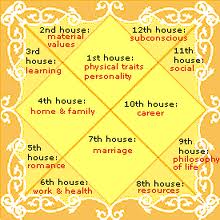- Astrology for Old People
- Astrology for Man/Woman
- Astrology for Marriage
- Astrology for Love
- Astrology for Student
- Astrology for Career/Job
- Astrology for Business
- Astrology for Money
- Astrology for Health
- Astrology for Child
- Astrology for Peace & Harmony
Importance of Birth Chart
By: J.N Pandey2 Dec 2010-
The Sanskrit for Horoscope is "Kundali". The birth chart or natal chart in Sanskrit is then called "Janma Kundali" . By definition a horoscope depicts the position of all the planets in heaven for given date, time and sun sign. This date and time is critical because planets are in constant motion and their positions are continuously changing. The horoscope indicates the position of each planet with respect to the 12 zodiac signs. Each Zodiac sign represents 30 degrees of movement for each planet and the 12 Zodiac signs represent 360 degrees movement of each planet. Each planet moves at different speeds and at varying speeds each day. We also do the Astrology sign compatibility so that you can know how compatible you are with your loved ones. Moon is the fastest moving planet, and it takes approximately two and half days to travel through each Zodiac sign.
Ascendant or Lagna: Saturn is the slowest planet among Vedic astrology planets. It takes approximately 21/2 to complete its movement through one zodiac sign. Uranus, Neptune and Pluto are even slower than Saturn. Apart from the position of each planet, the other most important parameter of the chart is called Ascendant or "Lagna" in Sanskrit. This is referred to as a point in a particular zodiac sign represented by a longitude expressed in degree, minutes and second and it is computed based on the exact Latitude/Longitude of the place where the particular person is born.

Every place on the surface of the earth has a unique ascendant sign and ascendant degree among the 12 zodiac signs at any given date and time of birth. The Ascendant point signifies the exact eastern horizon at the exact date, time and place of birth of a person. This is the unique space and time signature of a person. The Ascendant sign in the chart is also known as the first house of the chart. Every other sign in the zodiac then becomes the other houses in the chart in the anticlockwise direction. If the Ascendant sign is Aries in a horoscope chart, then the next zodiac sign in the anticlockwise direction is Taurus. Taurus will be considered as 2nd house in the chart. Similarly each of the 12 zodiac signs will then represent 12 houses in the chart. So the natal horoscope chart signifies the individual planet positions in different zodiac signs and the ascendant and 12 houses in the chart based on the date, time and place of birth. This is the permanent chart of an individual, which does not change as the birth details do not change.
Dasha Chart: Every birth chart has a dasha chart, which starts from the date and time of birth and is unique for every individual. This uniqueness comes from the start of the Dasha system for the person. A person's Dasha system can start from any point within the sequence described above. Once the starting point is computed from the birth chart, then it must follow the sequence given above. This starting point is not chosen at random but it follows a definite mathematical logic and is computed from the exact longitude and zodiac sign where Moon is located in the natal horoscope chart.
To analyze smaller time durations in a person's life, the Dasha system (Planet Main Period) can be further sub-divided into Antar Dasha (sub-period) or it can be further divided into 3 rd level of Pratyantar Dasha (sub-sub periods). Theoretically we can create charts even to 5th level covering few hours of a person's life, which is called Sukshma Dasha.
However it is not reliable or practical to create a chart beyond 3rd level as mentioned above because our birth time is never totally accurate, and even if a person has clear birth time recorded at the time of birth, the associated error will be exotically reflected beyond 3rd level and no reliable analysis can be done. Besides there are different opinions among Vedic astrologers on which moment during birth constitutes the actual birth time. I am not going to such controversies in this article. The dasha system reflects that planets deliver their natal promises during their period, sub-period and sub-sub periods as per the person's chart.
The birth chart becomes the main tool in the hands of an astrologer to predict when and what events will take place in a person's life.
About the Author
Visit cyberastro.com for Daily Horoscope and Astrology.
(ArticlesBase SC #532385)
Article Source: http://www.articlesbase.com/ - Importance of Birth Chart
- Daily Panchang
- Love Marriage Prediction in Astrology
- Details on Zodiac Signs Dates
- Tamil Astrology - An Accurate Form of Prediction
- New 13th Zodiac - Ophiuchus
- Miracles of Spiritual Healing
- 2011 Hindu Calenders
- Predictions for 2011
- About Chinese New Year 2011 - The Year of Rabbit
- Know Your Future with 2011 Horoscope and 2011 Astrology
- Top Ten IT Predictions for 2011
- Chinese New Year 2011 - Year of the Rabbit
